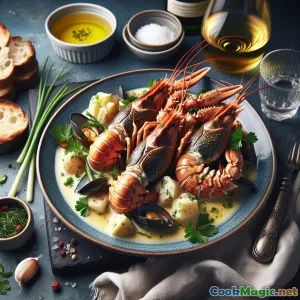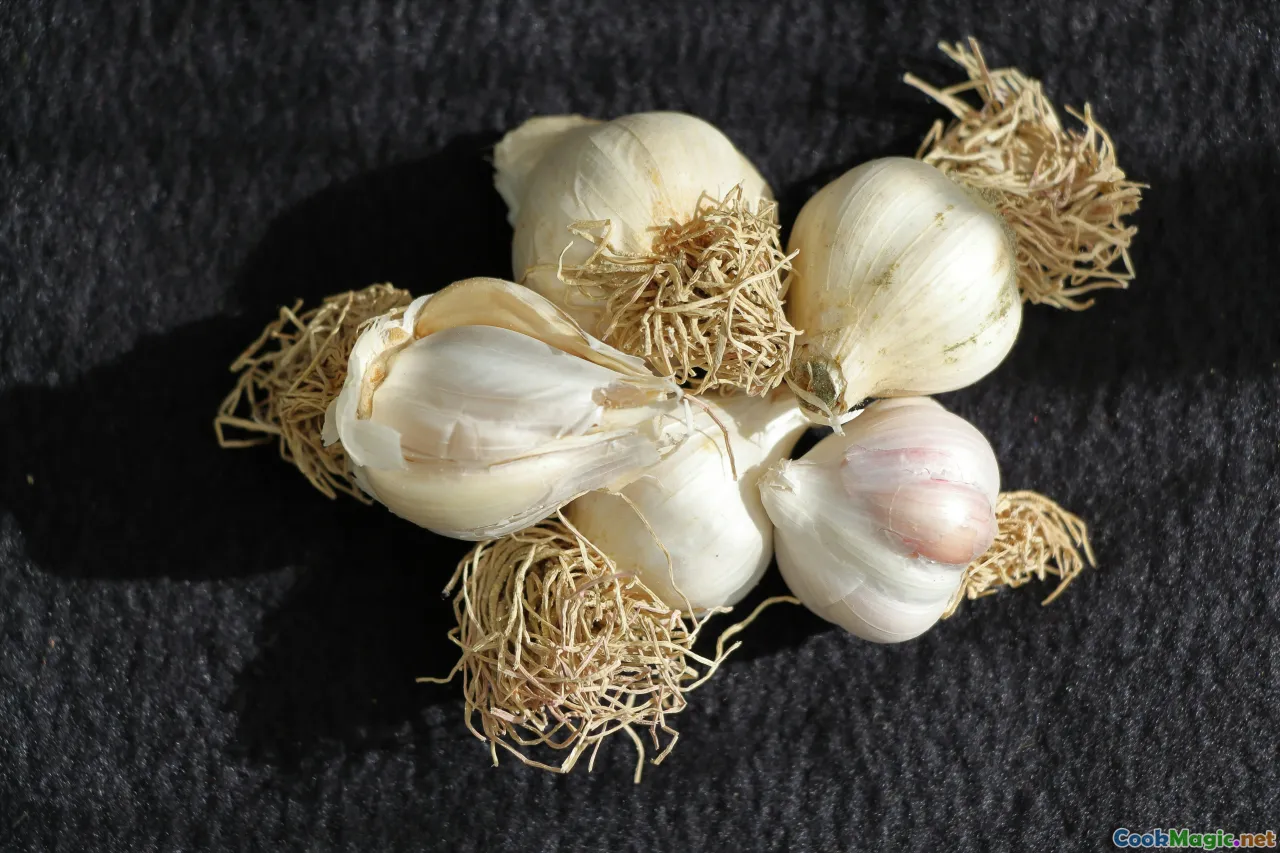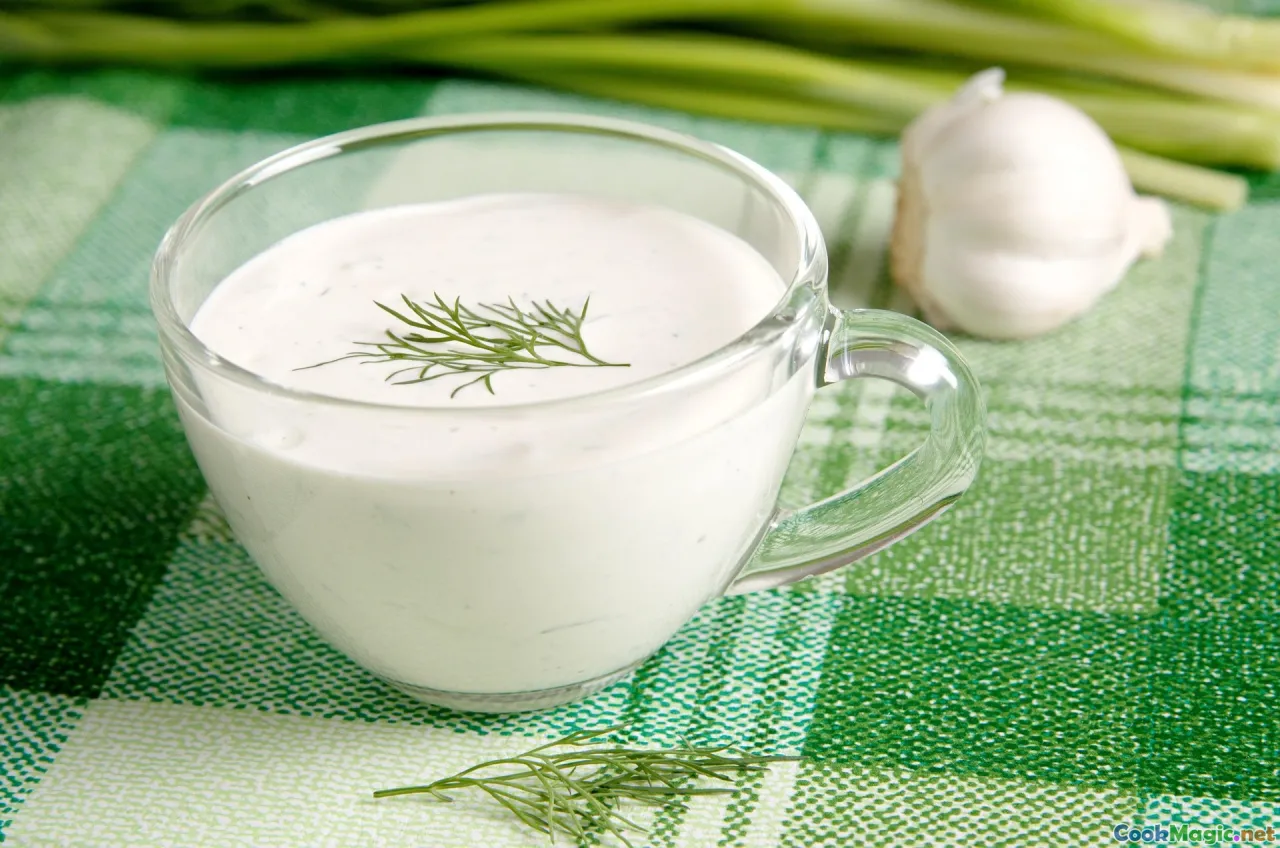
Hebridische Langusten mit samtiger Knoblauchcreme
(Hebridean Langoustines with Silky Garlic Cream)
(0 Bewertungen)0
346
Oktober 25, 2025
Problem melden
Zutaten
-
12 pieces Langustinen (mit Schale, roh)
(Fresh Hebridean or high-quality frozen; sustainably pot-caught if possible)
-
30 grams Ungesalzene Butter
(For sautéing and richness)
-
1 tbsp Olivenöl
(Helps prevent butter from scorching)
-
1 small Schalotte
(Fein gehackt)
-
4 cloves Knoblauch
(Mashed to a paste for smoother sauce)
-
80 ml trockener Weißwein
(Muscadet or a crisp coastal white)
-
15 ml Schottischer Whisky
(Hebridean malt for aroma; flambé optional)
-
80 ml Fisch- oder Schalentiere-Bouillon
(Homemade from shells if available)
-
200 ml Schlagsahne
(Brings silky body to the sauce)
-
0.5 tsp Zitronenschale
(Finely grated; adds brightness)
-
1 tbsp Zitronensaft
(Adjust to taste at the end)
-
1 tbsp Frischer Schnittlauch
(Finely snipped)
-
1 tbsp Glattblatt-Petersilie
(Chopped; for fresh finish)
-
0.75 tsp Hebriden-Meersalz oder Flockensalz
(Mit Geschmack abschmecken)
-
0.25 tsp Frisch gemahlener schwarzer Pfeffer
(Nach Geschmack)
-
0.5 tsp geräucherte Seetang-Flocken (Kombu)
(Amplifies maritime flavor)
-
2 slices Knuspriges Brot
(Toasted, for serving and mopping up sauce)
(Fresh Hebridean or high-quality frozen; sustainably pot-caught if possible)
(For sautéing and richness)
(Helps prevent butter from scorching)
(Fein gehackt)
(Mashed to a paste for smoother sauce)
(Muscadet or a crisp coastal white)
(Hebridean malt for aroma; flambé optional)
(Homemade from shells if available)
(Brings silky body to the sauce)
(Finely grated; adds brightness)
(Adjust to taste at the end)
(Finely snipped)
(Chopped; for fresh finish)
(Mit Geschmack abschmecken)
(Nach Geschmack)
(Amplifies maritime flavor)
(Toasted, for serving and mopping up sauce)
Nährwerte
- Portionen: 2
- Portionsgröße: 1 Teller (350g)
- Calories: 610 kcal
- Carbohydrates: 0 g
- Protein: 34 g
- Fat: 44 g
- Fiber: 0 g
- Sugar: 3 g
- Sodium: 780 mg
- Cholesterol: 290 mg
- Calcium: 180 mg
- Iron: 2.8 mg
Anweisungen
-
1 - Prep the langoustines:
If frozen, thaw in the fridge overnight. Rinse and pat dry. For easier eating, you may split each langoustine lengthwise with a sharp knife, keeping shells on for flavor.
-
2 - Warm the pan:
Heat a large skillet over medium-high. Add olive oil and half the butter until foaming subsides. Season langoustines lightly with sea salt.
-
3 - Sear for sweetness:
Sear langoustines cut-side down first (if split) or shell-on, in batches if needed, 45–60 seconds per side until just opaque. Remove to a warm plate; tent loosely.
-
4 - Aromatics and deglaze:
Lower heat to medium. Add remaining butter, then shallot; cook 1–2 minutes until translucent. Stir in garlic paste 30 seconds. Deglaze with white wine, scraping browned bits; simmer 1 minute to reduce by half.
-
5 - Build the cream sauce:
Add stock and reduce 1–2 minutes. Stir in double cream, lemon zest, a pinch of salt and pepper, and optional kelp flakes. Simmer gently 2–3 minutes until lightly thickened.
-
6 - Finish and balance:
Return langoustines and any juices to the pan to warm through 1 minute. Add lemon juice to taste. Swirl in Scotch whisky off the heat, or briefly flambé if desired.
-
7 - Herbs and serve:
Fold in chives and parsley. Taste and adjust seasoning. Serve immediately in warm bowls with crusty bread for the sauce.
If frozen, thaw in the fridge overnight. Rinse and pat dry. For easier eating, you may split each langoustine lengthwise with a sharp knife, keeping shells on for flavor.
Heat a large skillet over medium-high. Add olive oil and half the butter until foaming subsides. Season langoustines lightly with sea salt.
Sear langoustines cut-side down first (if split) or shell-on, in batches if needed, 45–60 seconds per side until just opaque. Remove to a warm plate; tent loosely.
Lower heat to medium. Add remaining butter, then shallot; cook 1–2 minutes until translucent. Stir in garlic paste 30 seconds. Deglaze with white wine, scraping browned bits; simmer 1 minute to reduce by half.
Add stock and reduce 1–2 minutes. Stir in double cream, lemon zest, a pinch of salt and pepper, and optional kelp flakes. Simmer gently 2–3 minutes until lightly thickened.
Return langoustines and any juices to the pan to warm through 1 minute. Add lemon juice to taste. Swirl in Scotch whisky off the heat, or briefly flambé if desired.
Fold in chives and parsley. Taste and adjust seasoning. Serve immediately in warm bowls with crusty bread for the sauce.
Mehr über: Hebridische Langusten mit samtiger Knoblauchcreme
Overview
Hebridean Langoustines in Garlic Cream is a dish that celebrates Scotland’s cold, pristine Atlantic waters. Langoustines, also known as Norway lobster or scampi, thrive around the Outer Hebrides, where strong tides, kelp forests, and rocky seabeds yield shellfish with a sweet, delicate flavor. This recipe pairs that natural sweetness with a silky garlic cream, lifted by a coastal white wine and finished with a gentle whisper of Scottish whisky. The result is elegant yet comforting, perfect for a special dinner that takes less than half an hour.
Why this works
- Searing shell-on langoustines first concentrates sweetness through light caramelization while keeping the flesh succulent.
- Deglazing with a crisp white wine dissolves the pan’s flavorful fond and adds brightness that balances dairy richness.
- A modest amount of quality stock extends depth, making the cream feel lighter but more savory.
- Lemon zest and juice add high notes at two moments: zest early for aromatic oils, juice at the end for fresh acidity.
- Chives and parsley deliver a clean, green finish that complements maritime flavors without overpowering.
Ingredient notes
- Langoustines: Fresh, pot-caught Hebridean langoustines are prized for sustainability and taste. If fresh is unavailable, high-quality frozen langoustines can be excellent; thaw slowly in the refrigerator for best texture.
- Cream: Double cream (heavy cream) yields a luxurious, spoon-coating sauce that remains stable. Avoid boiling vigorously; a gentle simmer preserves its silkiness.
- Wine and whisky: The wine provides bright acidity; whisky contributes a subtle peat or coastal aroma, depending on the malt. Use a light hand with the whisky—its role is perfume, not dominance.
- Salt: If you can source Hebridean sea salt or smoked sea salt, it echoes the dish’s origin and adds delicate mineral character.
- Kelp flakes: A small pinch of dried seaweed provides natural umami and a seashore fragrance without making the sauce fishy.
Technique tips
- Garlic paste: Smash chopped garlic with a pinch of salt using the side of a knife. Paste disperses evenly and prevents harsh, raw bits.
- Heat control: Start hot to sear, then lower to build the sauce. Cream prefers gentle heat. If the sauce gets too thick, splash in extra stock to loosen.
- Don’t overcook: Langoustines cook rapidly—aim for just opaque and springy. Overcooking turns them firm and can dull their sweetness.
- Flambé option: If flambéing whisky, briefly ignite off the heat with a long match and let the flame subside. Always keep a lid nearby and avoid overhead extraction fans.
Serving ideas
- Classic: Serve in warm bowls with crusty bread to catch every drop of sauce.
- Pasta: Toss freshly cooked tagliatelle through the sauce, adding a splash of pasta water to coat.
- Vegetables: Pair with simply steamed samphire or buttered new potatoes for a gentle, briny counterpoint.
Substitutions and variations
- Shellfish: Large wild prawns can stand in for langoustines, though the flavor will be slightly bolder.
- Dairy-free: Use a rich shellfish bisque reduced with olive oil and emulsified with a spoon of Dijon mustard to mimic body.
- Herbs: Swap chives for tarragon or dill for a different aromatic profile.
- Citrus: Orange zest offers a sweeter aromatic if lemon is too sharp.
Sustainability and sourcing
Hebridean fisheries often use pot-caught methods that are relatively selective and gentle on the seabed compared to trawling. Buy from reputable fishmongers who can confirm origin, and consider seasonality. If you receive the langoustines whole, use the heads and shells to make a quick stock by simmering with onion, fennel tops, and a strip of lemon peel for 20–25 minutes; this stock becomes the backbone of a deeply flavored sauce.
Cultural note
In Scottish coastal cooking, simplicity is a sign of respect for pristine ingredients. Cream, butter, and a splash of local spirit have long anchored Highland and island kitchens. This dish nods to that lineage while keeping technique modern and efficient. It is the kind of recipe you might imagine after a breezy ferry crossing: sea salt on your lips, the scent of peat smoke in the air, and the promise of something warm and restorative.
Troubleshooting
- Sauce split: If the sauce appears greasy, whisk in a tablespoon of cold cream off the heat to bring it back together.
- Too thick: Add a splash of warm stock or pasta water and gently swirl.
- Too mild: A few extra kelp flakes or a pinch more lemon can wake up the flavors.
Make-ahead and storage
This dish shines when cooked to order. If you must prepare ahead, make the sauce base (through the cream reduction) a few hours early and rewarm gently. Cook the langoustines à la minute for best texture. Leftovers can be cooled quickly, stored airtight, and reheated very gently within 24 hours, though the shellfish will be firmer upon reheating.
Pairings
- Wine: A mineral white such as Muscadet, Albariño, or a lean Chablis complements the maritime sweetness.
- Whisky: A gentle, coastal single malt with restrained peat echoes the sea without overshadowing the cream.
With just a handful of high-quality ingredients and thoughtful technique, Hebridean Langoustines in Garlic Cream distills a windswept shore into a bowl—luxurious, briny, and luminously simple.























